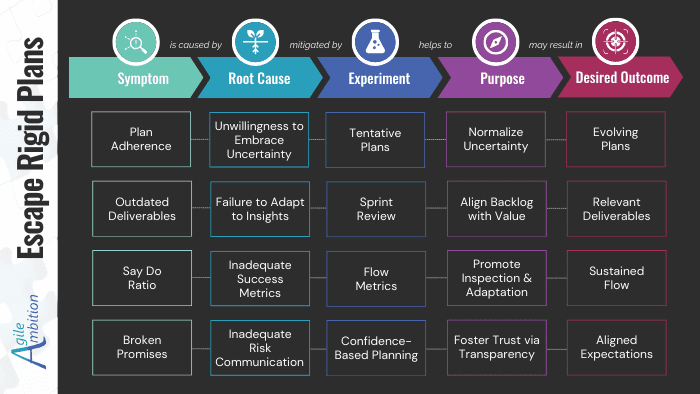Recalculating the Route: Escape Rigid Plans

Your GPS recalculates with every new turn of events. Why shouldn’t your plans be just as adaptable?

Does your team stick to rigid plans, fearing stakeholders will see any change as failure? It’s like ignoring your GPS when it offers a faster route—you stay stuck in traffic, frustrating everyone involved. But stakeholders don’t value unwavering adherence to a flawed plan; they value results. Recalculate and adapt to stay in tune with changing needs, embrace uncertainty, and deliver real value.
This issue offers four experiments to adapt without losing direction.
From Plan Adherence to Evolving Plans

The sunk cost fallacy tricks you into clinging to plans just because you’ve invested time in them. But sticking to a flawed plan is like sitting in traffic when your GPS offers a better route—pointless and frustrating. Plans are educated guesses, not guarantees. Instead of carving them in stone, pencil them in. Use terms like “contenders” or “suppositions” to signal that plans are tentative. Tentative language signals change and makes space for adaptability. Embracing evolving plans frees your team from rigid constraints. Remember, the goal isn’t to follow the route; it’s to reach the destination. So, reroute when needed and maximize the value of every turn.
Tentative plans empower teams to adapt confidently as new insights emerge, avoiding wasted effort on outdated ideas.
🤔 What would change if your team viewed evolving plans as a strength rather than a failure?
From Outdated Deliverables to Relevant Deliverables

Sticking to outdated plans delivers outdated features. Use the Sprint Review to check if your product goals still align with customer needs—it’s more than just a demo. Instead of letting the demo take center stage, use this time to recalibrate and adapt. Revamp the backlog to reflect value, not past assumptions. Prioritize today’s needs over yesterday’s plans. Regular recalibration helps you deliver features that hit the mark, not the recycle bin. Use the Sprint Review to reroute and stay on track to deliver value.
Adapting the Product Backlog during the Sprint Review keeps teams focused on delivering value, not just checking off tasks.
🤔 Are your Sprint Reviews helping you adapt to customer needs or just showcasing completed work?
From Say-Do Ratio to Sustained Flow

Teams often struggle to identify relevant success metrics, falling back on unhealthy ones like the say-do ratio. This metric, meant to show how well your team executes, ends up locking you into plans that don’t matter anymore. You might think pointing to the say-do ratio builds stakeholder trust— “See? We did what we said we’d do.” But if the outcomes you deliver aren’t meaningful, what do you think happens to trust?
If the venue for your holiday party changes while you’re en route, do you continue to the old venue and tell your family, “I kept my promise”? Of course not. They’d think you’d lost your mind.
Success isn’t just about doing what you said you’d do—it’s about delivering value. Flow metrics provide an evidence-based way to focus on continuous improvement. While our industry lacks perfect success metrics, demonstrating steady progress builds far more trust than rigid adherence to outdated plans.
Flow Metrics reframe success as steady improvement, not flawless execution.
🤔 What insights could flow metrics reveal about your team’s effectiveness that the say-do ratio misses?
From Broken Promises to Aligned Expectations

Stakeholders often interpret plans as promises. When a feature isn’t delivered precisely as planned, stakeholders view this as a broken promise—but this view is far too rigid. When you’re meeting a friend for coffee, do you promise to arrive at exactly 4:20, or do you give an estimated arrival time? If they’re late, do you cut ties or understand that unforeseen delays—like traffic or a gas stop—are part of life?
Confidence-based planning shifts the narrative. Saying, ‘We’re 85% certain we can deliver in 3 days,’ helps you communicate both timelines and risks. This confidence-based communication reframes deadlines as educated estimates, not guarantees, aligning expectations.
Confidence-based Planning minimizes conflict by framing timelines as estimates, not guarantees.
🤔 What would change if your team communicated risks and timelines with transparency rather than certainty?
TLDR;
Adhering to plans suffocates creativity and sets you up for failure. Innovate by treating plans as flexible guides, not constraints.

Start experimenting today—your team will thank you.
Share
Table Of Contents
Fuel an Idea
Every week, I break down complex ideas, strip away the fluff, and give you experiments to turn knowledge into skills.
If that’s worth a coffee, consider fueling the next big insight.
No pressure. No guilt trips. Just impact.
Buy Me a CoffeeRelated Posts
Quick Links
Legal Stuff

